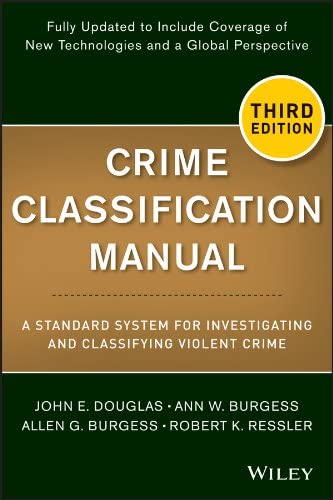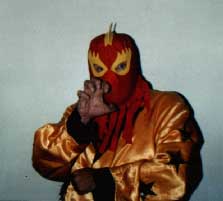One of my previous posts discussed John E. Douglas and his book, Mindhunter, and how it pulled back the curtain on how criminal profilers look at a crime, or criminals, and try to deduce a pattern. The themes that we cover today will be very similar because the book that is the topic of this essay actually came about before Mindhunter. Its sole purpose wasn’t to entertain True Crime aficionados as much as it was written to assist law enforcement.
The book in question is the Crime Classification Manual by John E. Douglas, Robert Ressler, Ann W. Burgess, and Allen G. Burgess. I currently have the third version, which is an updated version to include cyber crimes. Rather than type out such a long name, we will do what Douglas suggests and shorten the name to CCM-III, which was derived from the DSM-III. Another fact to note is that the DSM inspired the writing of the CCM. The DSM-III (Diagnostic and Statistical Manual of Mental Disorders – Third Edition – III) was developed in the late 1970s and it was updated to include the madness that we collectively felt as a country after one of the most tumultuous times in American History. The Third Edition even received a revision in 1987, adding an R to its title, because of changes in criteria. To understand the research going into this book, you have to look at what the 70s and 80s did to law enforcement as a whole. The rise of crime, and serial crime, in particular, had sent not just police and feds, but medical professionals scrambling to explain what the fuck was going on in the world. Information had to be altered, updated, or removed, due to the findings we had discovered well down the road.
The main reason the FBI wanted to write a CCM was because of the way that psychologists and doctors looked at the mentally ill. While they were interested in classifying and rehabbing these individuals, Douglas and the FBI’s main reason for doing their research was to prevent crime. The reasoning behind this is that if the information they have developed in regard to catching serial offenders was readily available to small, local law enforcement agencies, then they would no longer have to wait for federal assistance and conduct the bulk of what the FBI does on their own.
One thing you will learn very early when reading this book after reading Mindhunter is that most of the general information has already been covered. This is more of a technical approach. I liken it to Mindhunter representing you getting a burger. The meat and the ingredients are already prepared. You simply just have to ingest it. The CCM-III is like someone giving you a slab of beef along with some buns, fixings, and condiments. You are going to be getting the same nutritionally, but it is going to be ingested differently. You also have to put in more work when it comes to reading a textbook rather than a mass-market, True Crime book.
The main thing that the Feds want the police to look at is patterns. The correct way to approach any crime is to detach yourself emotionally to look at the crime objectively. The book argues that you won’t be able to see these if you are emotionally invested. Patterns can be telling because they can shed some light on what the killer wanted from the experience. Douglas and the feds hypothesize that these types of crimes are more about reenacting fantasies that have built up inside of the offenders. Because of this, the crimes will be as close to the fantasy as possible. When you hear profilers discuss the difference between MO and Signature, that is what they are referring to. An MO is a learned procedure, usually developed over time, where a killer or serial offender can obtain their target. It can change due to circumstances or experience. One example is Ted Bundy. Bundy used fake casts, as well as crutches and other excuses, to portray himself as a helpless young man who needed some assistance from friendly women. While there are similarities, it is not an unmoving approach. One thing most Bundy fanatics are also aware of is that almost all of the women had gone through an emotional event in their life, making them possibly more empathetic to someone in need of assistance. This was Bundy’s MO. Something that he developed to lure women away so that he could do what he wanted with them.
When it comes to Bundy’s signature, we can only speculate on the information he has given law enforcement, due to the way that he disposed of the bodies of his victims. But control, fear, and rage were the makeup of his Signature, which were the actions that were kept mainly static throughout the affairs; control being the biggest one because of how Bundy treated the victims AFTER their demise. The main reason Bundy abducted the women was to have something to control, as sick as that sounds. Because he had to do it with a living and breathing woman, at first, simply created the byproduct of murdering them, which in turn created the need for disposing of the bodies. This in turn transformed into possessing them, to the point of doing what he wanted to their bodies at will before disposal. One small fantasy birthed this huge habit that took control of Bundy’s life.
What we as normal humans can relate this to would be booze. If you have any friends who decided to indulge too much in their late teens or early twenties, chances are at some point, maybe even still, they developed a dependency on alcohol. Now think of all the shit they did to feed that dependency. Maybe they stole money. Maybe they cut off people they loved. Maybe they hung out with people they hated just because they could get drunk. Those are the same markings of the compulsion that you see with serial murder and rape. It’s just on a different, and more extreme, scale. After the offender drowns themself in this new reality they created, they must feed it more and more until it becomes out of control.
The human brain has always worked like that. When you get into therapy or start any journey of self-reflection, what you are told to do in order to get better is focus on a balance. Serial offenders most likely don’t have the tools to approach their issues, or previous attempts at getting better didn’t pan out as they intended.
Beginning as early as Douglas and Ressler’s first interviews, with serial murderer Ed Kemper, they found that there were underlying urges that would rear their ugly heads. Manipulation, domination, and control were all hallmarks to every person who was upfront about their cravings. Every person interviewed felt inadequate in their own personal life. They needed to fix that, and when conventional methods no longer worked or seemed too daunting, they handled their issues by other means.
That is what makes helping out these individuals so difficult. I think sometimes they are scared of what people will think, and other times they find comfort in the grotesque and strange, and they don’t see a point in trying to alter that train of thought. Fantasies don’t hurt anyone, right?
The thing is, they do! One thing that I have gathered after ingesting both of these books (not done with CCM-III as of yet, but you can definitely see the patterns) is that the people who commit these crimes had a lot of time to think about what they wanted to do. Things get scripted, planned out, and meticulously perpetrated. Otherwise, you run into problems. One thing I can think of as an example: when you have had a long day at work, and you have a yearning for some fast food on the way home, then you get to the place and either it’s closed or they fuck your order up so bad that the one thing you wanted from the day is ruined. You went through the trouble of living your normal ass life, doing all the work you needed to in order to get to that reward, and then something fucks it up. If you are like me, you probably won’t feel good until you go to the same place and get the right order. As sad as it sounds, that is what it can be like for serial offenders. The scene has to be perfect because they are most likely dealing with fantasy and trauma on a level where devious actions are the only thing that soothes their urges.
Thirdly, every person took gradual steps towards making the fantasy a reality. That can be done with experimentation with animals, inanimate objects, young children, or even with the offender themself. You see a ton of serial perpetrators diving into pornography as well. I think a big portion of the reasoning behind this is because porn is also drenched in fantasy, and it’s an easy step from what people concoct in their heads to seeing these fantasies laid out in paper or on film. If anything, it helps them rationalize what they are feeling. Other people must have these deviant thoughts on sex, right? Antisocial elements also are taken into account, as offenders see this as a way of revenge for the type of torment they had to endure themselves.
Going back to Mindhunter, the last chapter was eye-opening to me because Douglas writes about going to a Mystery Writer’s conference and laying out his research on serial crime, and finding the vast majority of the audience bored. This was from a book published in 1995, so I am sure the feelings of the writing community are different, especially after much more Thomas Harris books and movies. But, that is one thing that bugs me when I read or watch fiction based on serial killers. That shit can be hokey. I get the need to have some stereotypical painting of evil. I think you can believe in “evil” existing out in the world while also recognizing the need for evaluation. I think a fair amount of people are getting tired of the anti-hero, and “humanizing” monsters. But, to me, it’s really fucking silly to not shed light on how “monsters” used to be, and still are to some extent, normal and functioning human beings.
To get away from Serial Killers and move on to other forms of criminals, you could look at mobsters and gangsters as a perfect example. These are guys who are able to break people’s legs, execute hits, rob people, and are still able to tuck their children in at night with a kiss and a bedtime story. There are varying degrees to it, but it shows that compartmentalization is a huge aspect of criminality. No one walks around “evil” all the time. To think that and portray that is just silly.
I get it. The most exciting part about writing the current project is the stuff that we get to change. Doing things based on reality can be daunting and doing that much research is a chore. But, I think as a personal preference for me, I find someone turning into a monster to be more fascinating. I think it takes more work than people realize. Most of the people who do heinous shit have been thinking about it for years. The term “perfect storm” comes to mind. The other comfort we have is that as these crimes have become more prevalent, people have also been developing tools along with them. The issue that is brought up in the CCM-III though is that law enforcement will always be one step behind criminals due to the fact that perps have a head start in general. There is no way to prevent future crime. We used to not look at these crimes the same at all. The reason why killers were able to get massive body counts in the past was that if young women went missing, oftentimes it would be chalked up to them leaving home. I don’t know if that’s possible in 2022, but I would doubt it.
This book was fairly easy to obtain. You can buy a copy off Amazon or from your local bookstore, but it will cost a pretty penny. I took a chance with an interlibrary loan, and it worked out. This copy is from Arkansas State University, so if you put one in, chances are you may get this one. But rather than take the chance of being put on some list, like I probably was, you can probably just read Mindhunter and get the interesting bits from this textbook.



